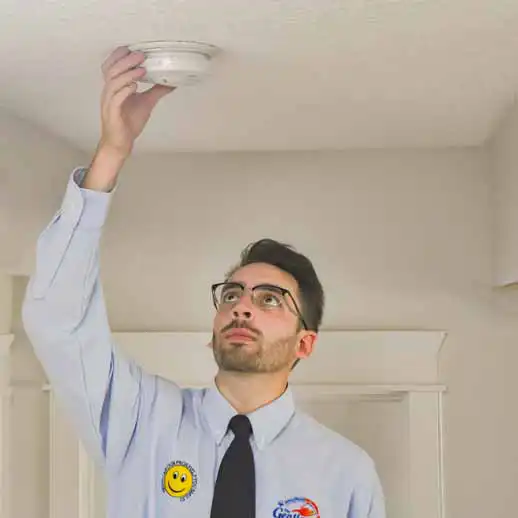
Same Day Service
Since 1992
Call The Gentleman Pros Now!
(403) 755-4914

Carbon monoxide detectors are important devices to keep you and your family healthy and safe. It alerts you when the carbon monoxide in your home reaches unsafe levels. The most reliable carbon monoxide detectors are the ones that are hard-wired into your electrical system. Hard-wired means the detector’s wiring is connected directly to the wiring in your house, like your lighting fixtures.
“Both technicians were friendly, professional and took their time to not only make sure we understood the current issue and recommendations, but also looked over other details such as furnace, hot water & electrical with an eye for ongoing maintenance. They arrived promptly to manage our emergency. Appreciate their care to keep our floors clean. Fixed price list made quotes straightforward. Very impressed!” Sara R

Carbon monoxide (CO) is a tasteless and colourless gas that has almost no smell. It is almost impossible to sense without a carbon monoxide detector. It is important to know when the carbon monoxide level in your house is too high.
Carbon monoxide has serious health implications when it reaches dangerous levels. At very high levels, it can cause convulsions, unconsciousness, coma, and even death. At lower levels, it can cause several symptoms including headaches, tiredness, dizziness, and trouble thinking. It is easy to misinterpret these symptoms because they can be the result of many different causes. This is why having properly installed carbon monoxide detectors is very important.
Use our skilled and knowledgeable electricians to install your carbon monoxide detectors and you can be confident they are installed properly, are in good working order, and meet all codes and best practices.
Call (403) 755-4914 to book today. Or you can talk with us online by clicking on the Chat With Us icon at the bottom of the page, or you can fill out our online form and we will quickly get back to you.
Keep your family safe and install hard-wired carbon monoxide detectors.

The carbon monoxide detector’s alarm should be tested monthly by pressing the TEST button on the unit.
Please note this will not tell you if the device is correctly detecting carbon monoxide. You can purchase test kits with a small can of carbon monoxide to test the detector’s operation.
The above is general information, please check the manufacturer’s user guide for instructions specific to your device.
The Alberta Building Code requires certified carbon monoxide detectors in every building that has a fuel-burning device and/or has an attached storage garage. For more information, please check out the Alberta Safety Codes Council information sheet.
Many of us live in homes built before these requirements came into force. So you might have to install detectors. But how many? The number of carbon monoxide detectors you should have is dependent on the size of your home.
We recommend you speak to an expert when deciding how many detectors to install.
You should have carbon monoxide detectors on each level of your home. They should also be located in the hallways of the sleeping areas of your home.
Please refer to the detector’s user guide to see at what height the detector should be installed. The Alberta Safety Codes Council carbon monoxide detector information sheet outlines the required locations for installation.
If you suspect you’ve been exposed to carbon monoxide, evacuate the building immediately and call 911.
If you can’t leave the building, open any windows and doors in the room. Then get as close to the open windows and/or doors as possible. Call 911.
When the emergency responders arrive they will look for the source of the carbon monoxide. Do not go back into your home until emergency responders tell you you can.
Carbon monoxide (CO) is produced when fuel is burned. Fuel such as:
In our homes, the most common sources of carbon monoxide include incorrectly installed or maintained:
Other sources of carbon monoxide include:
Carbon monoxide is dangerous for a few reasons.
Carbon monoxide binds with the hemoglobin in our blood creating carboxyhemoglobin. This reduces our blood’s capacity to carry and release oxygen to our tissues. It causes hypoxia.
The early symptoms of carbon monoxide symptoms are very similar to the symptoms of the flu including:
At higher levels, the symptoms include:
At very high levels, the symptoms include:
Carbon monoxide is virtually impossible to detect without carbon monoxide detectors. Carbon monoxide gas is colourless, tasteless, and almost odourless.
Carbon monoxide is lighter than air.
Carbon monoxide exposure can impact people differently. How exposure impacts you will depend on how long you are exposed, the concentration of carbon monoxide, your health, and the amount of activity you were doing while being exposed.
Generally speaking, one will start to experience mild carbon monoxide poisoning symptoms at 70 parts per million (ppm).
Serious symptoms including coma and death can occur when the concentration of carbon monoxide reaches 150 to 200 ppm and above.
The average level of carbon monoxide in homes is dependent on whether you have a gas stove or not.
In homes without a gas stove, the average concentration of carbon monoxide is 0.5 to 5 ppm.
In homes with properly adjusted gas stoves, the average concentration is 5 to 15 ppm.
In homes with poorly adjusted gas stoves, carbon monoxide concentrations can be 30 ppm and higher.
There are things you can do to reduce the risk of carbon monoxide building up in your home. They include:



